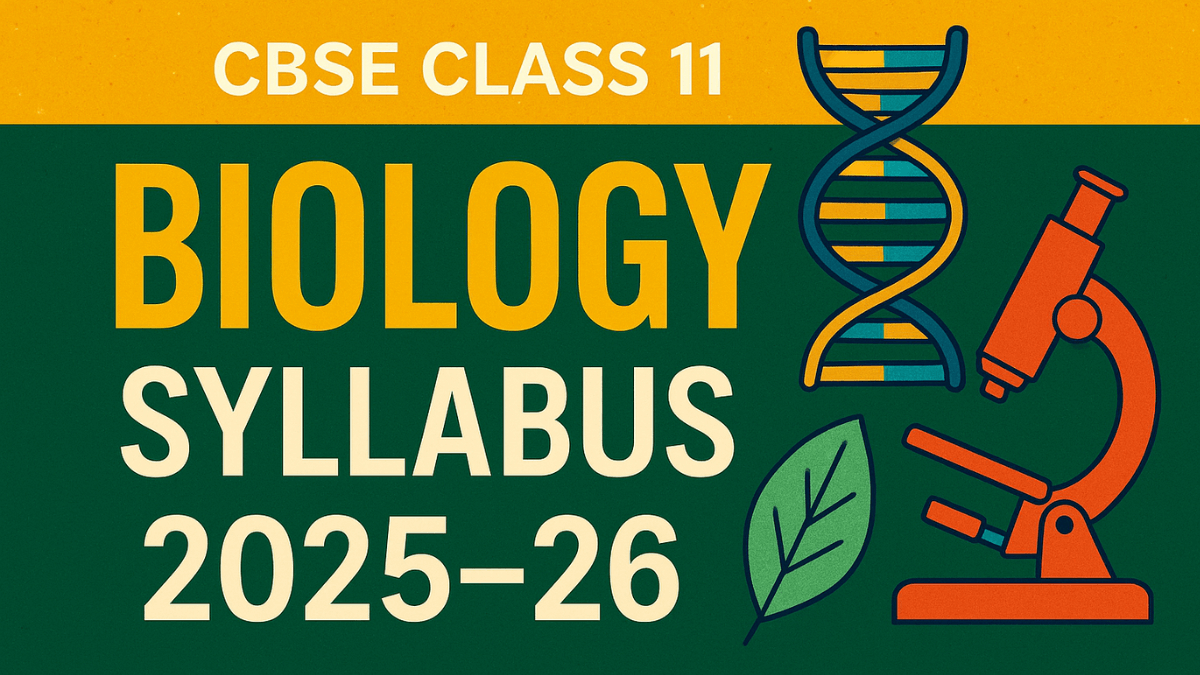Explore the CBSE Class 11 Biology syllabus 2025-26 by downloading the complete pdf copy here. The NCERT Biology Class 11 syllabus tells you about the wonders of life, biodiversity, genetics, human anatomy and develop a thorough understanding of cell structure. Students easily understand how life works. The paper format of Class 11th Biology enables a simple, clear, and sequential flow of concepts. Biology’s discoveries and advancements impact various aspects of life, including the environment, industry, health, and agriculture. The CBSE class 11 Biology syllabus 2026 PDF presents knowledge in an entertaining way.
CBSE Class 11 Biology Syllabus 2025-26
The CBSE Class 11 Biology Syllabus 2025-26 highlights common principles among animals, plants, and microorganisms, as well as the connection between biology and other fields of study. The Biology curriculum aims to develop skills in observation, experimentation, documentation, quantitative reasoning, and multi-disciplinary approaches. It also promote sensitivity to biological issues (e.g., environment, health) and awareness of community and scientific contributions. Continuously studying the chapters expands your knowledge and comprehension of the surrounding universe.
Class 11 Biology Syllabus 2026 Marking Scheme
Marks distribution of the 5 units of Class 11th Biology are here.
| Unit | Title | Marks |
| I | Diversity of Living Organisms | 15 |
| II | Structural Organisation in Plants and Animals | 10 |
| III | Cell: Structure and Function | 15 |
| IV | Plant Physiology | 12 |
| V | Human Physiology | 18 |
| Total | 70 |
Detailed Biology Class 11th Syllabus Chapter Wise
The unit wise, chapter wise and topic wise complete theory paper syllabus is tabulated below.
| Units | Detailed Chapter-Wise Syllabus |
| Unit I: Diversity of Living Organisms | Chapter 1: The Living World What is living? Biodiversity Need for classification Three domains of life Taxonomy and systematics Concept of species Taxonomical hierarchy Binomial nomenclature Tools for the study of taxonomy Chapter 2: Biological Classification Five Kingdom Classification Salient features and classification of Monera, Protista and Fungi Chapter 3: Plant Kingdom Salient features and classification of plants into major groups Angiosperms Chapter 4: Animal Kingdom Salient features and classification of animals |
| Unit II: Structural Organization in Animals and Plants | Chapter 5: Morphology of Flowering Plants Morphology and modifications: Tissues Chapter 6: Anatomy of Flowering Plants Anatomy and functions of different parts of flowering plants Chapter 7: Structural Organisation in Animals Animal tissues Morphology Anatomy and functions of different systems of an insect (Cockroach) |
| Unit III: Cell Structure and Function | Chapter 8: Cell-The Unit of Life Cell theory and cell as the basic unit of life Plant cell and animal cell Cell envelope Cell organelle’s structure and function Chapter 9: Biomolecules Chemical constituents of living cells Biomolecules Chapter 10: Cell Cycle and Cell Division Cell cycle Mitosis Meiosis Significance |
| Unit IV: Plant Physiology | Chapter 11: Transport in Plants Transport in plants Movement of water, gad & nutrients Cell transport Plant-water relations Long-distance transport of water Transpiration Uptake and translocation of mineral Diffusion of gases Chapter 12: Mineral Nutrition Essential minerals Macro and micro-nutrients and their role Deficiency symptoms Mineral toxicity Elementary idea of hydroponics as a method to study mineral nutrition Nitrogen metabolism Nitrogen cycle Biological nitrogen fixation Chapter 13: Photosynthesis in Higher Plants Cyclic and non-cyclic photophosphorylation Chemiosmotic hypothesis Photorespiration C3 and C4 pathways Factors affecting photosynthesis Chapter 14: Respiration in Plants Exchange of gases Cellular respiration Amphibolic pathways Respiratory quotient Chapter 15: Plant – Growth and Development Seed germination Phases of plant growth and plant growth rate Conditions of growth |
| Unit V: Human Physiology | Chapter 16: Digestion and Absorption Alimentary canal and digestive glands Peristalsis Digestion Egestion Nutritional and digestive disorders Chapter 17: Breathing and Exchange of Gases Respiratory organs in animals Respiratory system in humans Mechanism of breathing and its regulation in humans Disorders related to respiration Chapter 18: Body Fluids and Circulation Composition of blood Composition of lymph and its function The human circulatory system Cardiac cycle Double circulation Regulation of cardiac activity Disorders of the circulatory system Chapter 19: Excretory Products and Their Elimination Modes of excretion Human excretory system Urine formation Regulation of kidney function Role of other organs in excretion Disorders Dialysis and artificial kidney Chapter 20: Locomotion and Movement Types of movement Skeletal system and its functions Joints Disorders of the muscular and skeletal system Chapter 21: Neural Control and Coordination Neuron and nerves Generation and conduction of nerve impulse Reflex action Sensory perception Sense organs Chapter 22: Chemical Coordination and Integration Endocrine glands and hormones Human endocrine system Mechanism of Hormone Action Role of hormones as messengers |
Class 11 Biology Practical Exam 2026 Syllabus & Marking Scheme
Check the Biology Class 11 practical syllabus with marking scheme below:
| Evaluation Scheme | Marks | |
| One Major Experiment Part A (Experiment No- 1,3,7,8) | 5 Marks | |
| One Minor Experiment Part A (Experiment No- 6,9,10,11,12,13) | 4 Marks | |
| Slide Preparation Part A (Experiment No- 2,4,5) | 5 Marks | |
| Spotting Part B | 7 Marks | |
| Practical Record + Viva Voce | (Credit to the student’s work over the academic session may be given) |
4 Marks |
|
Project Record + Viva Voce
|
5 Marks | |
| Total | 30 Marks | |
NCERT Class 11 Biology Syllabus 2025-26 PDF Download
Get the latest NCERT syllabus of Class 11th Biology subject. Also download the usefull study material to complete the syllabus.
Download CBSE Class 11 Biology Syllabus 2025-26 PDF – Click Here to Download
Download Biology Study Material Free – Click Here
How to Prepare for Class 11th Biology Subject?
- We recommend that students arrange Class 11th NCERT biology books or other best preparation books. For the Class 11 Biology syllabus, NCERT books are the best option.
- You should have the BIOLOGY class 11th previous year’s question papers.
- Before going on to the next chapter, you should review PYQ papers for class 11 Biology with solutions or practice questions, once you have grasped the principles of the previous one.
- Do not study incessantly, We advise students to take short breaks. It will renew the mind. Go for a walk or converse with your teachers and classmates.
- Set a daily goal and Weekly goals of finishing a certain topic from your Biology syllabus for class 11. Continue revising your lessons.











 CUET History Syllabus 2026 (Updated), Do...
CUET History Syllabus 2026 (Updated), Do...
 CUET General Test Syllabus 2026 (Latest)...
CUET General Test Syllabus 2026 (Latest)...
 CUET Economics Syllabus 2026, Exam Patte...
CUET Economics Syllabus 2026, Exam Patte...














